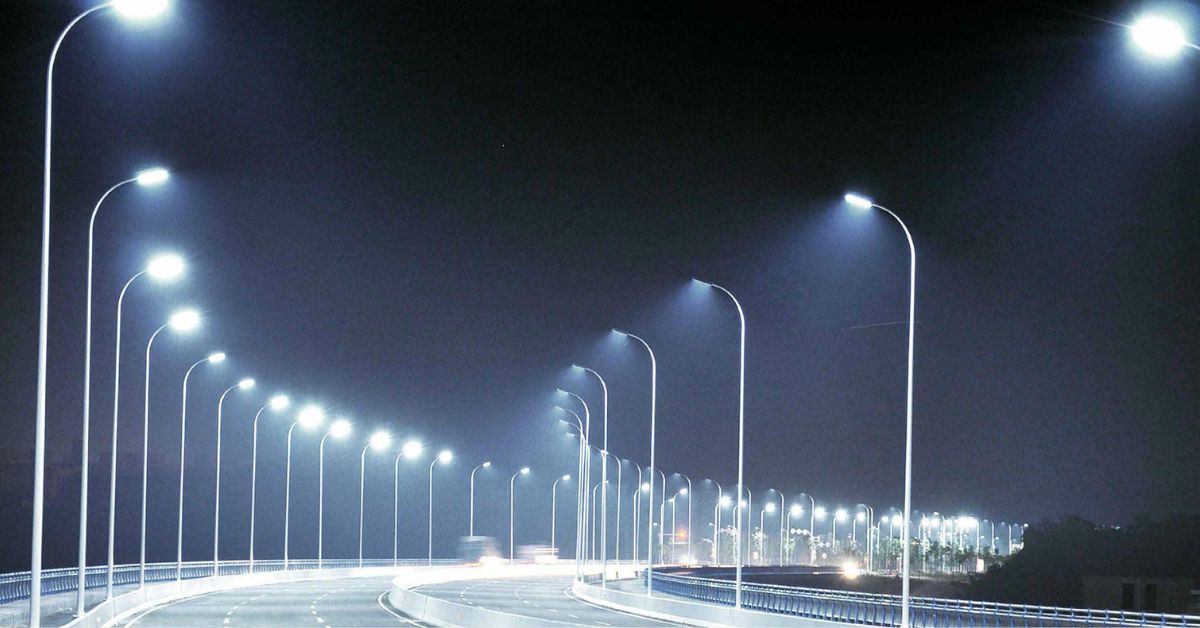Type II LED street lights are a specific kind of outdoor lighting. They have a special way of spreading light. These lights send most of their light forward and to the sides. They don’t send much light backward. This makes Type II LED street lights perfect for certain places.
The name “Type II” comes from a system that groups street lights by how they spread light. This system was made by the Illuminating Engineering Society (IES). They created Types I through V for different lighting needs.
Where Are Type II LED Street Lights Used?
Type II LED street lights work best in certain areas. Here are some common places you might see them:
- Narrow roads and streets
- Walkways and paths in parks
- Bike lanes
- Sidewalks along roads
- Residential streets
- Small parking lots
Type II LED street lights shine their light in an oval pattern. The light spreads about 1.75 times the height of the pole in front of the light. It also spreads about the same distance to each side. This pattern is longer than it is wide.
For example, if a Type II LED street light sits on a 20-foot pole, it will light up about 35 feet forward. It will also light about 20 feet to each side. This makes Type II LED street lights perfect for narrow roads or paths.
Benefits of Type II LED Street Lights
Type II LED street lights offer many advantages for cities and towns:
Energy Savings
Like all LED lights, Type II LED street lights use much less power than old-fashioned lights. They can save up to 70% of the energy that traditional lights use. This means lower electric bills for cities and towns.
Long Life
Type II LED street lights last much longer than older types of lights. A good LED street light can work for 50,000 to 100,000 hours. That’s about 11 to 22 years if the light is on for 12 hours each night! This means cities don’t need to replace the lights as often.
Better Light Direction
The main benefit of Type II LED street lights is how they direct light. They put light where it’s needed most. On a narrow street, they focus light on the road and nearby sidewalks. They don’t waste light by sending it backward or too far to the sides.
Less Light Pollution
Because Type II LED street lights aim their light carefully, they cause less light pollution. Light pollution happens when artificial light shines where it’s not wanted or needed. Type II LED street lights help keep the night sky darker and don’t shine into people’s homes as much.
Clear, Bright Light
LED lights produce clear, white light. This makes it easier for drivers and pedestrians to see colors correctly at night. This is much better than the yellow glow of older street lights.
How Type II LED Street Lights Compare to Other Types
Type II LED street lights are just one option among several types. Let’s look at how they compare:
Type I LED Street Lights
Type I lights have the narrowest light pattern. They shine light straight ahead and not much to the sides. They work well for very narrow paths or walkways. Type II LED street lights spread light a bit wider than Type I.
Type III LED Street Lights
Type III lights spread light even wider than Type II LED street lights. The light pattern is about 2.75 times the pole height in front of the light. These work well for wider roads and larger areas.
Type IV LED Street Lights
Type IV lights have a very wide forward throw. They can light areas up to 4 times the pole height in front of the light. These are good for very wide roads or mounting lights on the sides of large areas.
Type V LED Street Lights
Type V lights spread light in all directions equally. They create a circular pattern of light. These are often used in open areas like parks or large intersections.
Type II LED street lights fit between Types I and III. They provide a good balance for many common street lighting needs.
Installing Type II LED Street Lights
When planning to install Type II LED street lights, several factors matter:
Pole Height
The height of the light pole affects how wide an area the light covers. For Type II LED street lights, common pole heights range from 15 to 30 feet. Higher poles light larger areas, but the light becomes less intense.
Pole Spacing
Type II LED street lights work best when placed at the right distance from each other. Too far apart, and dark spots form between lights. Too close, and you waste money on extra lights. For Type II LED street lights, poles often work well when spaced at about 3-4 times the pole height.
Light Output
The brightness of Type II LED street lights is measured in lumens. Most street lights range from 5,000 to 30,000 lumens. The right brightness depends on the area being lit. Busier roads need brighter lights.
Color Temperature
LED lights come in different color temperatures, measured in Kelvins (K). For street lighting, 4000K to 5000K is common. This produces a clear white light that helps people see well at night.
Maintaining Type II LED Street Lights
One big advantage of Type II LED street lights is that they need less maintenance than older lights. However, they still need some care:
Regular Cleaning
Dirt and dust can build up on the lens of the light fixture. This reduces how much light reaches the ground. Cleaning the lens every few years helps keep the light working well.
Checking Connections
Sometimes electrical connections can come loose or corrode. This can make lights flicker or fail. Checking connections every few years prevents problems.
Replacing Drivers
While the LED chips last a very long time, the electronic drivers that power them might fail sooner. If a Type II LED street light stops working, often just the driver needs replacement, not the whole light.
Choosing the Right Type II LED Street Lights
If you’re looking to install Type II LED street lights, consider these factors:
Quality Matters
Not all Type II LED street lights are the same quality. Better lights may cost more upfront but save money over time. They last longer and use less energy.
Local Conditions
Consider your local weather. Type II LED street lights in very hot or cold places need special designs to handle temperature extremes.
Lighting Standards
Many places have rules about street lighting. These might specify how bright the light should be or what color temperature to use. Check local regulations before installing Type II LED street lights.
Budget Considerations
While Type II LED street lights save money over time, they do cost more upfront than some other options. Consider both the initial cost and the long-term savings when making your choice.
Case Studies: Type II LED Street Lights in Action
Many cities have switched to Type II LED street lights with great results:
Small Town Success
A small town in the Midwest replaced 500 old street lights with Type II LED street lights. Their electric bill dropped by 65%. They also saved money on maintenance since the new lights rarely needed fixing.
City Park Safety
A city park installed Type II LED street lights along its walking paths. The clear, well-directed light made people feel safer using the park at night. Park usage after dark increased by 40%.
Residential Street Improvement
A neighborhood replaced its old yellow street lights with Type II LED street lights. Residents reported better visibility at night. They also noticed less light shining into their homes due to the directed pattern of Type II LED street lights.
Conclusion
Type II LED street lights offer a perfect solution for many street lighting needs. They direct light where it’s most needed on narrow to medium-width streets. They save energy, last a long time, and reduce light pollution.







